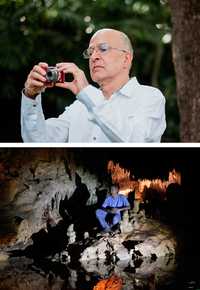Archaeology and mystery come together in the third volume of Shadows and Whispers

Archaeology and mystery come together in the third volume of Shadows and Whispers
Omar González Morales
La Jornada Newspaper, Friday, July 11, 2025, p. 4
With the third volume of the book Shadows and Whispers: Strange Experiences in Archaeology, anthropologists, historians, and researchers of the past have completed a broad narrative exercise that has allowed them to sharpen their pens
and invite readers to delve into strange tales, such as the sighting of aluxes or the hearing of tumultuous commotions in ancient ruins.
In an interview with La Jornada, the editors of the trilogy, archaeologists Luis Alberto López Wario and Luis Alberto Martos López, from the National Institute of Anthropology and History (INAH), spoke about this literary exercise that allowed anthropologists to transcend their limitations to venture into literature and at the same time bring the public closer to a lesser-known facet of their work.
The intention isn't to close the subject of our stories, but quite the opposite. When we started, we only planned one volume, but the reception from the public and our colleagues prompted us to release the second, and now this third. We felt the need to explore our literary vein
, commented López Wario.
The more than 90 stories compiled in the three volumes of Shadows and Whispers demonstrate that archaeologists are not just people who record the past, or who interpret it, but rather part of a necessary social circle that allows us to understand the mythologies of those who came before us
, said researcher Luis Alberto Martos.
We wanted to share experiences so the audience could feel connected to our daily lives as archaeologists, to experience what it's like to immerse themselves in this discipline that goes beyond books and connects us directly to the past, not just architecturally, but socially and culturally. With myths and legends
, the researcher said.
Who hasn't heard myths like those of La Llorona or the Aluxes? These stories are part of our social identity as a whole. To deny them is to conceal the way in which we inherited these religious-mythological aspects
, he added.
The three volumes, the first published in 2022 ( https://acortar.link/Lz9c02 ) and the second in 2024 ( https://acortar.link/L6drzd ), are approached with simple prose. The archaeologists, ethnologists, anthropologists, and scientists who collaborated come not only from Mexico but from all over the continent, and their narrative techniques were respected with their respective idioms, which are explained with footnotes.

▲ Archaeologists Luis Alberto Martos and Luis Alberto López, authors of the trilogy. Photo courtesy of the INAH and the author.
At first, with my colleagues, it was a matter of jumping into the fray without fear, but now our pens feel more free. We learned to write as we went along, so we respect each other's style when telling our stories
, Luis Alberto López said.
We learned to build bridges with society, because ultimately, it's the community that supports us in our work; we want to make visible the human meaning of our work and show the appeal of earlier human societies. In these three books, we find a vein that unites mystery, archaeology, and the ability to connect with the public
, explained López Wario.
We like to think there are things we can't yet explain. The advantage of this book is that it's not our intention to explain anything, but rather to share our experiences in the field, as anyone in any discipline might, although not everyone has the opportunity to spend the night in the ruins of an ancient city in the middle of the jungle or mountains
, the experts stated.
Martos explained that the El Hormiguero site in Campeche, located in 1933 by American archaeologists, was discovered in a curious way: "The place was discovered after some chicleros and a cook told the researchers about 'some enormous ruins from whose main building strange noises were coming.' So these stories are not unrelated to our archaeological discoveries."
For a long time, our specialty was merely a description of material elements, which are important data, but for us, the most important thing is the human meaning; that's what we wanted to capture in this book
, López Wario concluded.
The third volume of Shadows and Whispers: Strange Experiences in Archaeology will be presented tomorrow at 2:00 p.m. at the National Museum of World Cultures (Moneda 13, Historic Center), with free admission.
jornada

